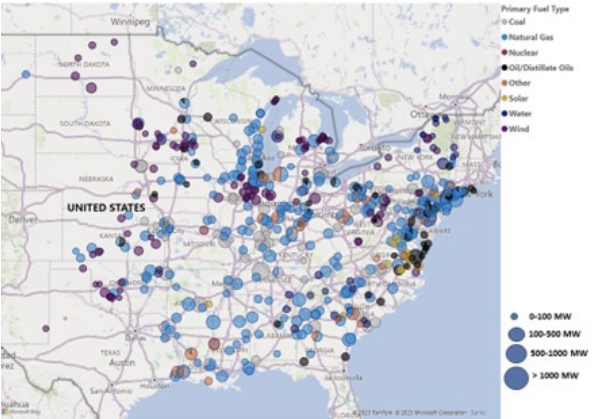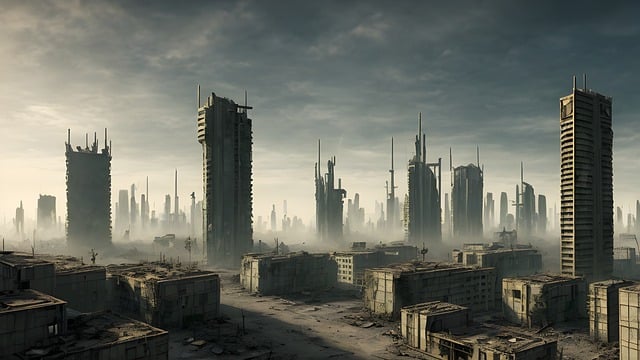Our cities are more fragile than we imagine
During the winter storm called “Elliott” last Christmas, gas pipes came close to freezing in New York. The gas shortages are not just deadly themselves in cold weather, but more of the electrical network is dependent on gas now rather than coal, and therein lies double jeopardy. As the gas crisis escalated, so did the electrical one: at its worst there were “90,500 megawatts of coincident unplanned generation unit outages, derates and failures… “. This was on top of 37,000 megawatts of generation that was already out of service, so 127 gigawatts in toto*. Some 18% of the normal resources of the Eastern Interconnection was missing.
At 4:25am on Christmas Eve in North Eastern USA the grid frequency fell to 59.936 Hz, just below the trigger point of 59.95 Hz.
If the gas had stopped flowing completely during the big freeze that lasted five days, water pipes would have frozen, and not only would the water stop flowing out of taps, and toilets stop flushing, but pipes would have burst — rendering thousands of apartment blocks and offices unusable, and possibly water damaged too.
Somehow, like a disaster movie script — 8.5 million people in New York City would need to be evacuated in the midst of this frozen crisis. They’d need to live somewhere else, while the slow tedious work of repairing and rebuilding the system would take months. Gas networks are far slower to restore than electrical blackouts. Robert Boyce tells how in one gas crisis in Washington State, 35,000 customers lost gas and the gas-company had to send someone out to every customer, firstly to turn off the gas meters, and then later when the line was fixed, they had to send someone out to light the pilot lights on every property. Even with more than 1,000 people working on the problem it still took nearly a week to restore gas services.
In New York, Con Edison, the company that nearly lost the gas system, has 1.1 million customers.
Via SmallDeadAnimals
Bone-Chilling
Last Christmas, the U.S. narrowly averted an energy disaster that would have decimated New York City and killed thousands
By Robert Bryce
In bone-dry language, the report “Inquiry into Bulk-Power System Operations During December 2022 Winter Storm Elliott,” explains how the gas pipeline network in New York nearly failed last Christmas when temperatures plummeted during the bomb cyclone. Freeze-related production declines, combined with soaring demand from power plants, homes, and businesses, led to shortages of gas throughout the Northeast. The lack of gas, as well as mechanical and electrical issues, resulted in an “unprecedented” loss of electric generation capacity totaling some 90,000 megawatts. While the lack of electricity was dangerous, the possibility of a loss of pressure in the natural gas network should send a bone-chilling shiver through the sacroiliac of every politician and bureaucrat in Washington, D.C., New York and the Northeast.
The report explains that if the gas pipeline system had failed, the recovery process in New York City would have taken “months.”
Hold your breath, this is not a freak rare event. The FERC report states this was the fifth in the last 11 years in which cold weather outages “jeopardized grid reliability”.
The US has become very dependent on natural gas, but there are risks…
Over the last few decades the US energy networks have been transformed with cheap shale gas. But as Robert Boyce explains, gas is a “just in time” fuel, unlike coal which can be stored on site in quantities large enough to survive a short crisis, or uranium, which can run for a couple of years.
It appears policymakers have been numbed into complacency about large generation outages and near-catastrophic misses over the past decade that include events like Winter Storms Uri and Elliott. But this latest near-catastrophe must be put into context. As mentioned above, NERC and FERC have repeatedly warned that the electric grid has become too dependent on natural gas. I love natural gas. And the increased use of gas (at the expense of coal) in the power sector has helped the U.S. cut its carbon dioxide emissions more than any other country in the world. But unlike coal — and the enriched uranium that fuels a nuclear power plant— gas is a just-in-time fuel. That makes it vulnerable to disruptions in service. And if gas supplies run short, so will electricity supplies.
The Billionaire SuperClass is working to make everything worse:
In all, [Michael] Bloomberg has committed more than $1 billion to a group of radical NGOs — including the League of Conservation Voters, Sierra Club, Rocky Mountain Institute, and Earthjustice, all of which have operating budgets of more than $100 million per year — who are aiming to undermine the integrity, affordability, and resilience of our electric grid.
The punchline here is obvious: America’s critical energy networks are nearing catastrophic breaking points due to underinvestment in reliable sources of fuel and generation, and by that, I mean pipelines, nuclear plants, and coal- and gas-fired power plants.
The Eastern Interconnection is huge, and outages were rife:

Figure 2: Location and Fuel Type of Unplanned Generation Outages and Derates During the Event (Bubble Size by MW for each Outage), as of December 24, 202
h/t AnotherIan
*Was (doh) megawatts typo. Apologies.
Image by ThankYouFantasyPictures
